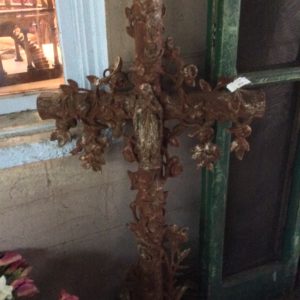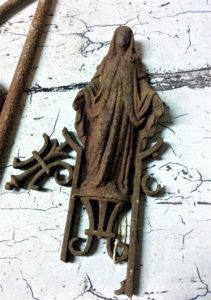French field crosses are sought after, even in parts they are prized decor
Antique crosses, especially those fashioned as crucifixes, are common throughout Europe, most notably in Roman Catholic countries. Whether they are made of stone, wood or metal they have a varied history, as well as special names wherever they are found. Named for their purpose, placement or their specific function, each has a history, rich and ancient. There are some, known as “wayside” crosses that are used to mark a road, path or sometimes placed at an intersection. They were once special marks for pilgrims journeying to a holy site. Or they sometimes served as a warning of a treacherous situation ahead such as a narrow cliff path or a dangerously marshy area. Most often they just marked the road for travelers. Many of these crosses are centuries old and sometimes they have inscriptions telling the story of why and by whom the cross was placed in that spot. These wayside crosses are often noted on maps, and serve as a secondary aid in navigation. In the Alps for example one finds wooden crosses in all sizes, some small and barely noticeable and others made of massive carved beams. It is customary to replace them as they age and decay with new ones placed in the exact same spot. Stone crosses last much longer, although many such crosses were destroyed in French occupied areas of Germany due to post French Revolution sentiments against religion. Only a few survived, thanks to locals who secreted them away. Farms and vineyards in many countries also display crosses. Sometimes placed at the entrance to a farm, or in fields and vineyards, they can have a variety of meanings. Some are set up as a petition for protection from extreme natural disasters such as hail storms or flooding, and thus they earned names like “hail” or “weather” crosses. Certain crosses called “votive” crosses commemorate a vow made by someone or to signify the faith of the local community. Another common custom, crosses are set up as a sign of gratitude for having escaped death at war or from pestilence, some of these are known as “plague” crosses. One particular custom that has now spread to many other countries besides those in Europe, is the placing of an “accident” cross by the side of a road in memory of and to mark the place where someone died in the way. Some of the most historically notable crosses include the “Swedish Cross” on the North loop of the Nurburg racing circuit in Germany, and the many crucifixes set up all over Hungary to commemorate the routing of the Ottomans who had occupied the area. Some of those original crosses dating back to the year 1594 are still found in Austria and Germany and are known as “Turk” crosses. Here at the Cottage, we have only collected the metal crosses for obvious reasons, French vineyard or field crosses. They are truly works of art, and even some of their component parts are highly-prized for use in interior and exterior decor.












